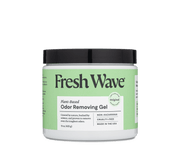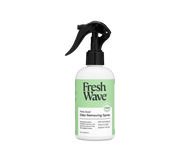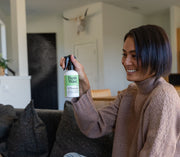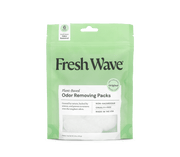The Winter Funk: What It Is and How to Fight It
Winter brings with it a magical ambiance of snowfall, cozy blankets, and warm beverages by the fireplace. However, for many, it also ushers in a period of low mood, decreased energy, and overall malaise. This phenomenon, commonly known as the "winter funk," is a real struggle for a significant portion of the population. As the days become shorter and colder, people tend to spend more time indoors, which can have a profound impact on mental health and happiness. In this blog post, we'll explore why winter affects mental well-being and provide practical tips on creating a healthy, positive atmosphere at home to combat the winter funk. Plus, we'll delve into the role of air quality in influencing mood, focus, and behavior, with Fresh Wave products offering a solution to ensure a fresh and uplifting indoor environment.
Understanding the Winter Funk
Research indicates that the decrease in sunlight during winter months can disrupt our circadian rhythm, the body's internal clock that regulates sleep-wake cycles. This disruption can lead to feelings of lethargy, irritability, and even seasonal affective disorder (SAD), a type of depression that occurs at a specific time of year, typically in the winter months.
A study published in the journal JAMA Psychiatry found that individuals with SAD experience alterations in their circadian rhythms, which contribute to the characteristic symptoms of the disorder [1]. Reduced exposure to natural light during the winter months can disrupt the production of serotonin and melatonin, neurotransmitters that play key roles in regulating mood and sleep patterns. As a result, individuals may experience changes in energy levels, appetite, and mood, contributing to the onset of seasonal affective disorder.
Tips for Creating a Healthy, Positive Atmosphere
- Maximize Natural Light: Open curtains and blinds during the day to let in as much natural light as possible. Sit near windows while working or relaxing to boost mood and energy levels.
- Stay Active: Engage in regular physical activity to combat the winter blues. Exercise releases endorphins, which are natural mood lifters. Consider indoor activities like yoga, dancing, or home workouts to stay active even when it's cold outside.
- Maintain a Routine: Stick to a consistent daily routine to provide structure and stability during the winter months. Set regular wake-up times, meal schedules, and bedtime routines to maintain a sense of normalcy.
- Bring the Outdoors In: Incorporate elements of nature into your indoor space, such as houseplants, fresh flowers, or nature-inspired decor. Surrounding yourself with greenery can evoke feelings of calmness and vitality.
- Create Cozy Spaces: Make your home a sanctuary by creating cozy nooks with soft blankets, plush cushions, and warm lighting. Designate areas for relaxation, reading, or meditation to promote moments of tranquility and rejuvenation.
The Role of Air Quality in Mental Well-being
Studies have shown a strong correlation between indoor air quality and mental health outcomes. Poor air quality, characterized by high levels of pollutants and odors, can negatively impact mood, concentration, and overall cognitive function. Research suggests that exposure to indoor air pollutants can increase the risk of developing mental health disorders such as anxiety and depression.
One study conducted by Harvard T.H. Chan School of Public Health found that higher levels of indoor air pollutants, such as volatile organic compounds (VOCs) and particulate matter, were associated with increased risk of depression and anxiety symptoms [2]. Another study published in the journal Environmental Health Perspectives revealed that improved indoor air quality was linked to better cognitive function and reduced symptoms of depression and anxiety among office workers [3].
Using Fresh Wave Products for a Calm, Odor-Free Atmosphere
Fresh Wave offers a range of innovative products designed to combat odors and improve indoor air quality naturally. Here's how you can use them to create a calm, odor-free atmosphere at home:
- Gels: Place Fresh Wave Gels in areas prone to odors, such as bathrooms, closets, or pet areas. The natural odor-eliminating ingredients will continuously neutralize unwanted smells, leaving your home smelling fresh and clean.
- Sprays: Use Fresh Wave Sprays to instantly refresh fabrics, upholstery, and air. Simply spritz the spray onto surfaces or in the air to eliminate odors and create a pleasant environment.
- Packs: Place Fresh Wave Packs in drawers, gym bags, or trash cans to absorb and neutralize odors at the source. These convenient packs are discreet and effective, providing long-lasting odor control wherever you need it.
- Candles: Light Fresh Wave Candles to infuse your home with a soothing, natural fragrance. The candles use essential oils and plant-based ingredients to neutralize odors and create a calming ambiance.
Conclusion
The winter funk is a common struggle for many individuals during the colder months, but it doesn't have to overshadow the season entirely. By implementing simple strategies to enhance your indoor environment and prioritize mental wellness, you can combat the winter blues and embrace the joys of winter. Remember to maximize natural light, stay active, maintain a routine, bring the outdoors in, and create cozy spaces within your home. Additionally, prioritize air quality with Fresh Wave products to eliminate odors and create a fresh, uplifting atmosphere that supports your mental and emotional health. With these tips and tools at your disposal, you can navigate the winter season with a positive mindset and a warm heart.
References:
- Rosenthal, N. E., Sack, D. A., Jacobsen, F. M., James, S. P., Parry, B. L., Arendt, J., ... & Tamarkin, L. (1985). Melatonin in seasonal affective disorder and phototherapy. JAMA Psychiatry, 42(2), 113-114.
- Zhang, X., Fan, Z., Li, Y., & Zhang, X. (2019). Associations of long-term exposure to ambient air pollutants with depression and anxiety in patients with chronic rhinosinusitis. Environmental Science and Pollution Research International, 26(20), 20736–20744.
- Allen, J. G., MacNaughton, P., Satish, U., Santanam, S., Vallarino, J., & Spengler, J. D. (2016). Associations of cognitive function scores with carbon dioxide, ventilation, and volatile organic compound exposures in office workers: a controlled exposure study of green and conventional office environments. Environmental Health Perspectives, 124(6), 805–812.









